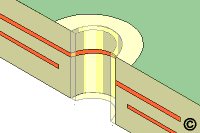No. 4.3.3
Deleting Inner Layer Connection at a Plated Hole, Drill
Through Method
OUTLINE
This method is used on multilayer circuit boards or assemblies to disconnect an
internal connection at a plated hole. A Precision Drill System is used with a
carbide drill, end mill or ball mill to drill out the hole. The hole may then be
filled with epoxy and redrilled to the diameter needed.
CAUTION
Extreme care must be taken to prevent damage to adjacent circuits. A microscope
must be used during milling when extreme accuracy is required.
TOOLS & MATERIALS
Cleaner
Color Agent
Continuity Meter
End Mills
Epoxy
Microscope
Oven
Pin Clamps
Precision Drill System
Tape, Kapton
Wipes
PROCEDURE
- Identify the hole that requires rework and clean the area.
- Mark the coordinates on the board surface and pin the circuit board in place on
the base plate of the Precision Drill System. (See Figure 1).
- Select the appropriate size end mill, drill or ball mill and insert it into
the chuck of the Precision Drill System. The cutting tool should be
approximately 0.50 mm (.020") greater than the plated through hole inside
diameter. Set speed to high.
CAUTION
Abrasion operations can generate electrostatic charges.
NOTE
End mills are normally single end, two or four flute high grade solid carbide.
- Completely mill through the hole to isolate the internal connection(s). A
microscope should be used for accuracy. (See Figure 2).
- Blow away material with air and clean the area.
- Check continuity to be sure that the internal connection has been deleted.
Also check the continuity and inspect the neighboring circuits to make sure that
none of them have been severed or damaged.
If desired complete the following steps
- Mask the opposite side with Kapton tape or flexible mask to
prevent the epoxy from flowing out the opposite side.
- Mix the epoxy.
- Fill the hole with epoxy up to and flush with the surface. Remove excess
epoxy. (See Figure 3).
NOTE
A slight overfill of epoxy may be desired to allow for shrinkage when epoxy
cures.
- Cure the epoxy per Procedure 2.7 Epoxy Mixing and Handling.
CAUTION
Some components may be sensitive to high temperature.
- Clean the area
- Select an end mill or drill as needed. Insert the cutting tool into the
Precision Drill System. Mill directly through the center of the cured epoxy. The
surface pad remaining may be used as a target location for accuracy. A
microscope should be used during milling for accuracy. (See Figure 4).
CAUTION
Be careful not to re-expose the internal layers of the hole when drilling out
the epoxy.
- Clean the area. Inspect the new hole using a microscope.
EVALUATION
- Visual and electrical examination as required
|






